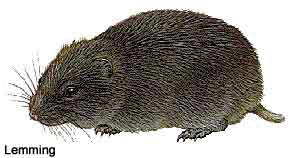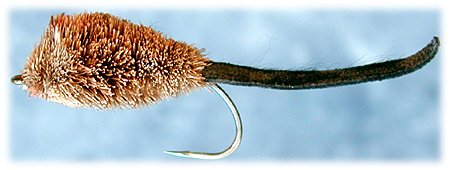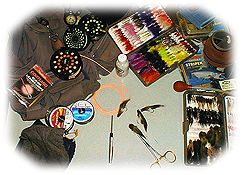
|
Mickey On The Menu?
Alaskan waters produce large trout, most notably the Rainbow. Genetics are a factor, but the nutritional opportunities for trout in Alaska are beyond compare. The most obvious examples come from returning salmon that enter freshwater streams by the millions to spawn and then die. During their freshwater lifecycle they deposit tons of eggs that are available to trout, then after spawning, every salmon will die leaving its carcass as another nutritional source. Later, as the eggs hatch, the alevin, fry and smolt will become prey as fish pursue another outstanding biomass. During times when there's less food, trout becomes opportunists and mice are a welcome meal.
 Mice live throughout Alaska and they're found around homes, in camps, or along grassy trails, but what we think is a mouse, could instead be a close relative. Besides mice, Lemmings, Voles, and Shrews inhabit most of Alaska in remarkable numbers. Distinguishing among the species can be difficult to the untrained eye, but they look enough alike that fly tiers can copy them with a single pattern. As a group, they range from 2 to 5 inches long and their colors are mostly brown or gray with many having a reddish coloration on their backs. [Shrew on right] Mice live throughout Alaska and they're found around homes, in camps, or along grassy trails, but what we think is a mouse, could instead be a close relative. Besides mice, Lemmings, Voles, and Shrews inhabit most of Alaska in remarkable numbers. Distinguishing among the species can be difficult to the untrained eye, but they look enough alike that fly tiers can copy them with a single pattern. As a group, they range from 2 to 5 inches long and their colors are mostly brown or gray with many having a reddish coloration on their backs. [Shrew on right]
 Some species live a lonely lifestyle while others colonize, but they're all prone to overpopulation of their habitat. Alaska's rodents mature and begin breeding at 3 to 6 weeks of age, and have a gestation period of 2 1/2 to 3 weeks producing 2 to 10 young. In a short time, populations can explode causing large numbers to leave in search of a more suitable habitat, which places them within reach of predatory fish. Streams, rivers, lakes and ponds should be obstacles, but mice and their cousins have little fear of the water and swim surprisingly well. Rainbows, Lake Trout, Pike and Char will actively hunt the swimmers, or take mice after they have drowned. Some species live a lonely lifestyle while others colonize, but they're all prone to overpopulation of their habitat. Alaska's rodents mature and begin breeding at 3 to 6 weeks of age, and have a gestation period of 2 1/2 to 3 weeks producing 2 to 10 young. In a short time, populations can explode causing large numbers to leave in search of a more suitable habitat, which places them within reach of predatory fish. Streams, rivers, lakes and ponds should be obstacles, but mice and their cousins have little fear of the water and swim surprisingly well. Rainbows, Lake Trout, Pike and Char will actively hunt the swimmers, or take mice after they have drowned.
 A live mouse presentation is often productive in slow moving water with grassy banks or other vegetation that suits small rodents. It seems logical that mice choose to make a water crossing in easy currents, but they're not that intelligent. The productivity of these areas is most likely credited to the rodent's clean silhouette and surface disturbance that makes them visible, easy prey. Some anglers do well using a slow, struggling retrieve along the banks where mice accidentally fall in, while others find success in the middle of the river where mice would be making a crossing. [Vole pictured] A live mouse presentation is often productive in slow moving water with grassy banks or other vegetation that suits small rodents. It seems logical that mice choose to make a water crossing in easy currents, but they're not that intelligent. The productivity of these areas is most likely credited to the rodent's clean silhouette and surface disturbance that makes them visible, easy prey. Some anglers do well using a slow, struggling retrieve along the banks where mice accidentally fall in, while others find success in the middle of the river where mice would be making a crossing. [Vole pictured]

A dead drifted pattern can be effective where big riffles or rapids tail into deep pools. Obviously, a poor choice of crossing locations result in drowned mice that wash downstream to waiting fish below. A spun hair pattern will naturally sink below the surface in fast water, or flies pressed into streamside mud with a boot decrease in buoyancy. As with many large patterns, it's a good idea to wait for a brief moment after the take before setting the hook. Often, fish strike the pattern but won't have it firmly in their mouth until after they turn to take it below the surface. Regardless of the method or means, if trout or other predatory fish are looking for mice, it will be an exhilarating experience.

Alaska Flyfishing Online
|
All Content Copyright ©1996-2003
Visual Media Design, Alaska Outdoor Journal, Alaska Flyfishing Online
All Rights Reserved
|
|




